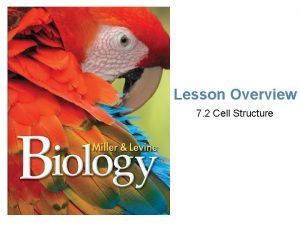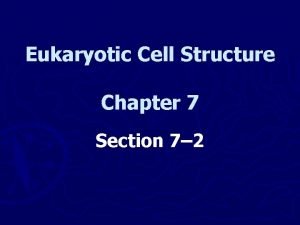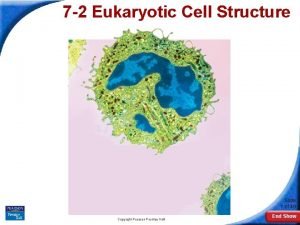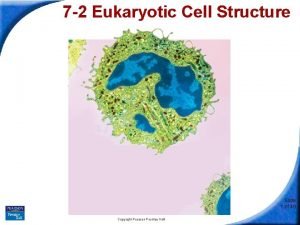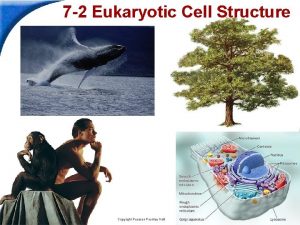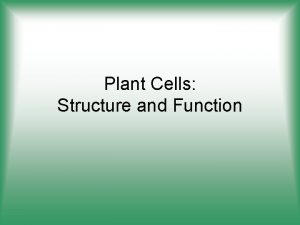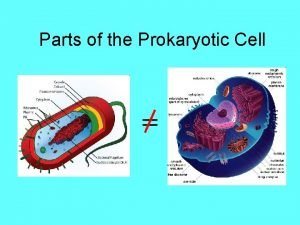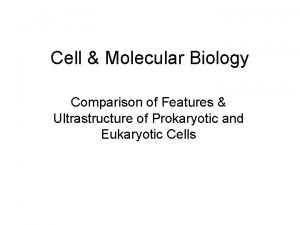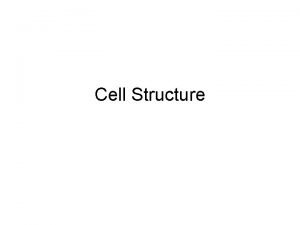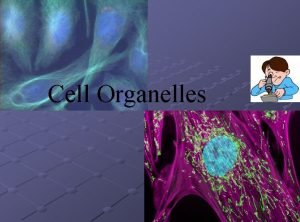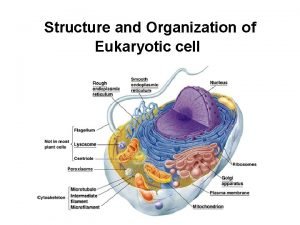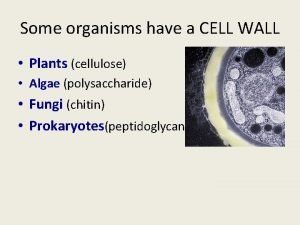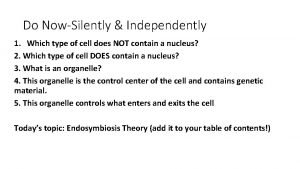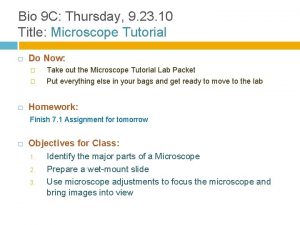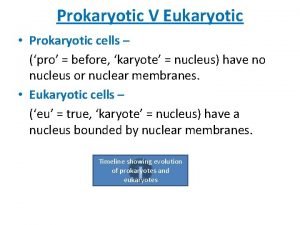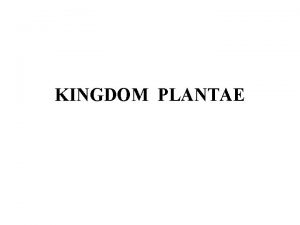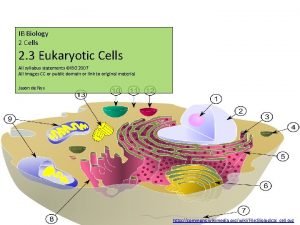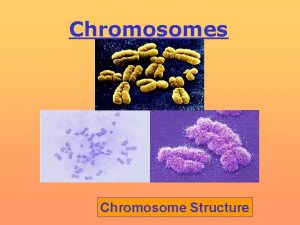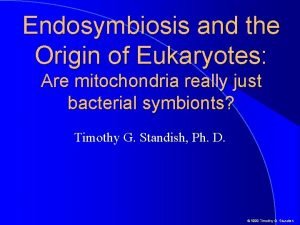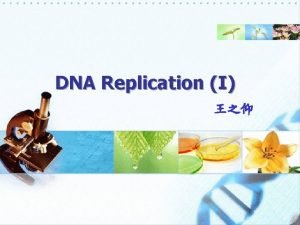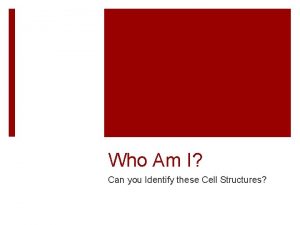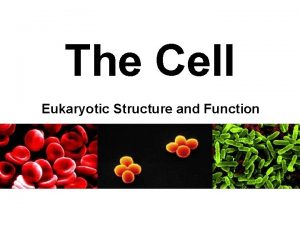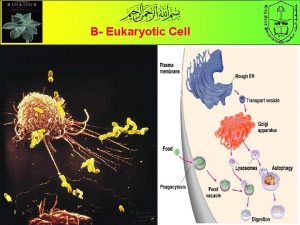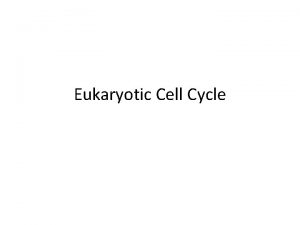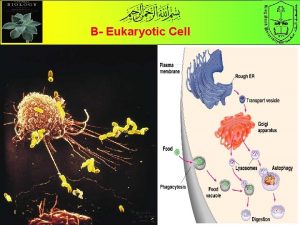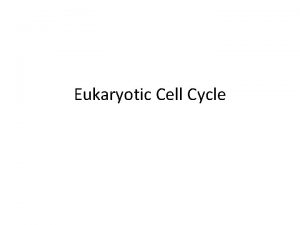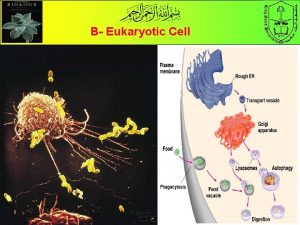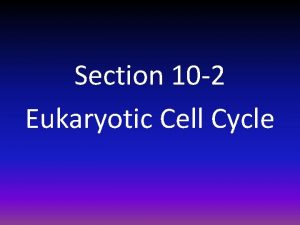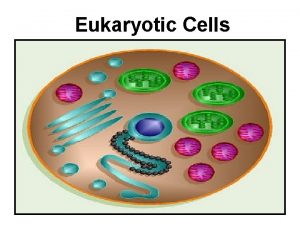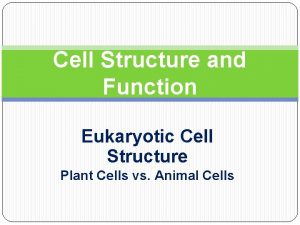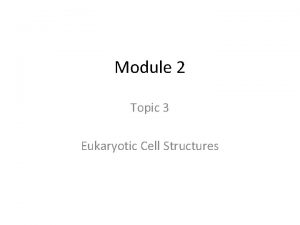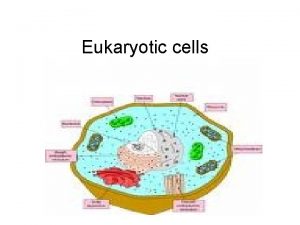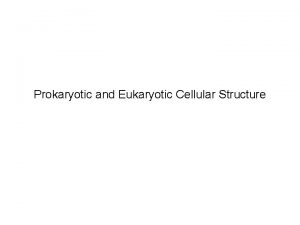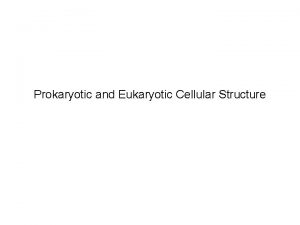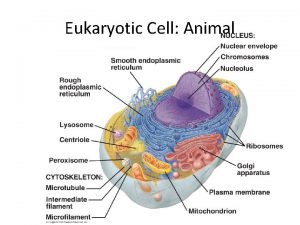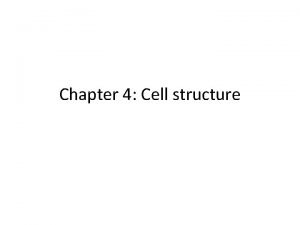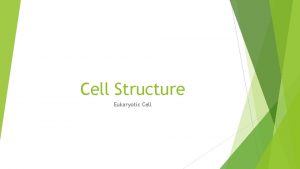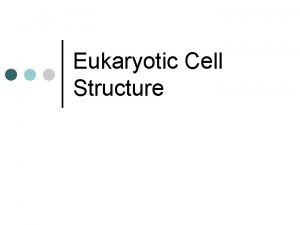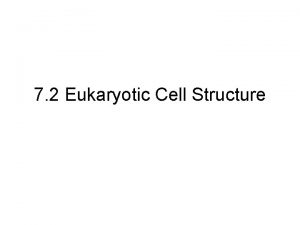7 2 Eukaryotic Cell Structure Eukaryotic Cell Structures








































- Slides: 40

§ 7 -2 Eukaryotic Cell Structure

Eukaryotic Cell Structures § Structures within a eukaryotic cell that perform important cellular functions are known as organelles. § Cell biologists divide the eukaryotic cell into two major parts: the nucleus and the cytoplasm. § The Cytoplasm is the portion of the cell outside the nucleus.

Eukaryotic Cell Structures Nucleus Smooth endoplasmic reticulum Rough endoplasmic reticulum Cell wall Cell membrane Chloroplast Nucleolus Nuclear envelope Ribosome (free) Ribosome (attached) Golgi apparatus Mitochondrion Vacuole

Eukaryotic Cell Structures Nucleolus Nucleus Nuclear envelope Rough endoplasmic reticulum Smooth endoplasmic reticulum Ribosome (free) Cell membrane Ribosome (attached) Centrioles Mitochondrion Golgi apparatus

Nucleus What is the functionof the nucleus? – The nucleus is the control center of the cell. – The nucleus contains nearly all the cell's DNA and with it the coded instructions for making proteins and other important molecules.

Nucleus § The Nucleus Chromatin Nucleolus Nuclear envelope Nuclear pores

Nucleus § The nucleus is surrounded by a nuclear envelope composed of two membranes. § The envelope is dotted with nuclear pores, which allow material to move in and out of the Nuclear nucleus. envelope Nuclear pores

Nucleus § The granular material in the nucleus is called chromatin. § Chromatin consists of DNA bound to protein.

Nucleus § When a cell divides, chromatin condenses to form chromosomes. § Chromosomes contain the genetic information that is passed from one generation of cells to the next.

Nucleus § Most nuclei also contain a nucleolus. § The nucleolus is where the assembly of Nucleolus ribosomes begins.

Ribosomes § What are the function of the ribosomes? § Ribosomes – One of the most important jobs carried out in the cell is making proteins. – Proteins are assembled on ribosomes. – Ribosomes are small particles of RNA and protein found throughout the cytoplasm.

Ribosomes § Ribosomes produce proteins by following coded instructions that come from the nucleus. § Cells that are active in protein synthesis are often packed with ribosomes.

Endoplasmic Reticulum § What is the function of the endoplasmic reticulum? § Endoplasmic Reticulum – Eukaryotic cells contain an internal membrane system called the endoplasmic reticulum, or ER. – The endoplasmic reticulum is where lipid components of the cell membrane are assembled, along with proteins and other materials that are exported from the cell.

Endoplasmic Reticulum Ribosomes

Endoplasmic Reticulum § There are two types of ER—rough and smooth. § The portion of the ER involved in protein synthesis is called rough endoplasmic reticulum, or rough ER. § Ribosomes are found on the surface of rough ER. § Rough ER is abundant in cells that produce large amounts of protein for export.

Endoplasmic Reticulum § Smooth ER does not have ribosomes on its surface. § Smooth ER contains collections of enzymes that perform specialized tasks, such as synthesis of membrane lipids and detoxification of drugs.

Golgi Apparatus § What is the function of the Golgi apparatus? § Golgi Apparatus § Proteins produced in the rough ER move into the Golgi apparatus.

Golgi Apparatus § The Golgi apparatus appears as a stack of closely apposed membranes.

Golgi Apparatus – The Golgi apparatus modifies, sorts, and packages proteins and other materials from the endoplasmic reticulum for storage in the cell or secretion outside the cell. – From the Golgi apparatus, proteins are then “shipped” to their final destinations throughout the cell or outside of the cell.

Lysosomes § What are the function of lysosomes? § Lysosomes are small organelles filled with enzymes. § Lysosomes break down lipids, carbohydrates, and proteins into small molecules that can be used by the rest of the cell. § Lysosomes also break down organelles that have outlived their usefulness.

Vacuoles § What are the function of vacuoles? § Vacuoles § Some cells contain saclike structures called vacuoles that store materials such as water, salts, proteins, and carbohydrates.

Vacuoles § In many plant cells there is a single, large central vacuole filled with liquid. § The pressure of the central vacuole allows plants to support heavy structures such as leaves and flowers. Vacuole

Vacuoles Contractile vacuole § Vacuoles are also found in some unicellular organisms and in some animals. § The paramecium contains a contractile vacuole that pumps excess water out of the cell.

Mitochondria and Chloroplasts § What are the function of the mitochondria? § Mitochondria – Nearly all eukaryotic cells contain mitochondria. – Mitochondria convert the chemical energy stored in food into compounds that are more convenient for the cell to use. Mitochondrion

Mitochondria and Chloroplasts § Mitochondria are enclosed by two membranes—an outer membrane and an inner membrane. § The inner membrane is folded up inside the organelle.

Mitochondria and Chloroplasts Chloroplast § What are the function of the chloroplasts? § Chloroplasts – Plants and some other organisms contain chloroplasts. – Chloroplasts capture energy from sunlight and convert it into chemical energy in a process called photosynthesis.

Mitochondria and Chloroplasts § Chloroplasts are surrounded by two membranes. § Chloroplasts contain the green pigment chlorophyll.

Cytoskeleton § Eukaryotic cells are given their shape and internal organization by the cytoskeleton.

Cytoskeleton § What are the functions of the cytoskeleton? – The cytoskeleton is a network of protein filaments that helps the cell to maintain its shape. The cytoskeleton is also involved in movement. – The cytoskeleton is made up of: § microfilaments § microtubules

Cytoskeleton

Cytoskeleton – Microfilaments § Microfilaments: – – are threadlike structures made up of the protein actin. form extensive networks in some cells. produce a tough, flexible framework that supports the cell. help some cells move.

Cytoskeleton – Microtubules § Microtubules are hollow structures made up of proteins known as tubulins. Microtubules: – maintain cell shape. – are important in cell division. – build projections from the cell surface—cilia and flagella— that enable some cells to swim rapidly through liquids.

Cytoskeleton § In animal cells, structures known as centrioles are formed from tubulin. § Centrioles are located near the nucleus and help to organize cell division.

7 -2 Review Quiz

7 -2 – In the nucleus of a cell, the DNA is usually visible as § a dense region called the nucleolus. § the nuclear envelope. § granular material called chromatin. § condensed bodies called chloroplasts.

7 -2 – Two functions of vacuoles are storing materials and helping to § break down organelles. § assemble proteins. § maintain homeostasis. § make new organelles.

7 -2 – Chloroplasts are found in the cells of § plants only. § plants and some other organisms. § all eukaryotes. § most prokaryotes.

7 -2 – Which of the following is NOT a function of the Golgi apparatus? § synthesize proteins. § modify proteins. § sort proteins. § package proteins.

7 -2 – Which of the following is a function of the cytoskeleton? § manufactures new cell organelles § assists in movement of some cells from one place to another § releases energy in cells § modifies, sorts, and packages proteins

END OF SECTION
 Prokaryotic cell vs eukaryotic cell
Prokaryotic cell vs eukaryotic cell Prokaryotic reproduction
Prokaryotic reproduction Life
Life Eukaryotic cell animal cell
Eukaryotic cell animal cell Prokaryotic cells vs eukaryotic cells
Prokaryotic cells vs eukaryotic cells Eukaryotic cell structure
Eukaryotic cell structure Section 7-2 eukaryotic cell structure
Section 7-2 eukaryotic cell structure Eukaryotic cell structure
Eukaryotic cell structure Section 7-2 eukaryotic cell structure
Section 7-2 eukaryotic cell structure Section 7-2 eukaryotic cell structure
Section 7-2 eukaryotic cell structure Section 7-2 eukaryotic cell structure
Section 7-2 eukaryotic cell structure Eukaryotic plant cell diagram
Eukaryotic plant cell diagram Cell organelles structures and functions organizer
Cell organelles structures and functions organizer Homologous structures example
Homologous structures example Parts of a prokaryotic cell
Parts of a prokaryotic cell Typical eukaryotic cell
Typical eukaryotic cell Eukaryotic cell organisation
Eukaryotic cell organisation Cytoskeleton prokaryotic or eukaryotic
Cytoskeleton prokaryotic or eukaryotic Eukaryotic cells
Eukaryotic cells Dialysis membrane
Dialysis membrane Are cell walls prokaryotic or eukaryotic
Are cell walls prokaryotic or eukaryotic Are plants multicellular eukaryotes
Are plants multicellular eukaryotes Plant cell
Plant cell Organelle speed dating
Organelle speed dating Karyote
Karyote Algae classification kingdom
Algae classification kingdom Ib biology eukaryotic cell diagram
Ib biology eukaryotic cell diagram Which compares prokaryotes and eukaryotes
Which compares prokaryotes and eukaryotes Prokaryotic chromosome vs eukaryotic chromosome structure
Prokaryotic chromosome vs eukaryotic chromosome structure Eukaryotic chromosome structure
Eukaryotic chromosome structure Eukaryotic chromosome structure
Eukaryotic chromosome structure Eukaryotic chromosome structure
Eukaryotic chromosome structure Animal cell structures
Animal cell structures What organelles name means colored bodies
What organelles name means colored bodies Composite cell diagram
Composite cell diagram Organelle graphic organizer
Organelle graphic organizer Golgi body school analogy
Golgi body school analogy Denuding tower
Denuding tower Plant vs animal cell
Plant vs animal cell Spontaneity of redox reactions
Spontaneity of redox reactions Dry cell vs wet cell
Dry cell vs wet cell





